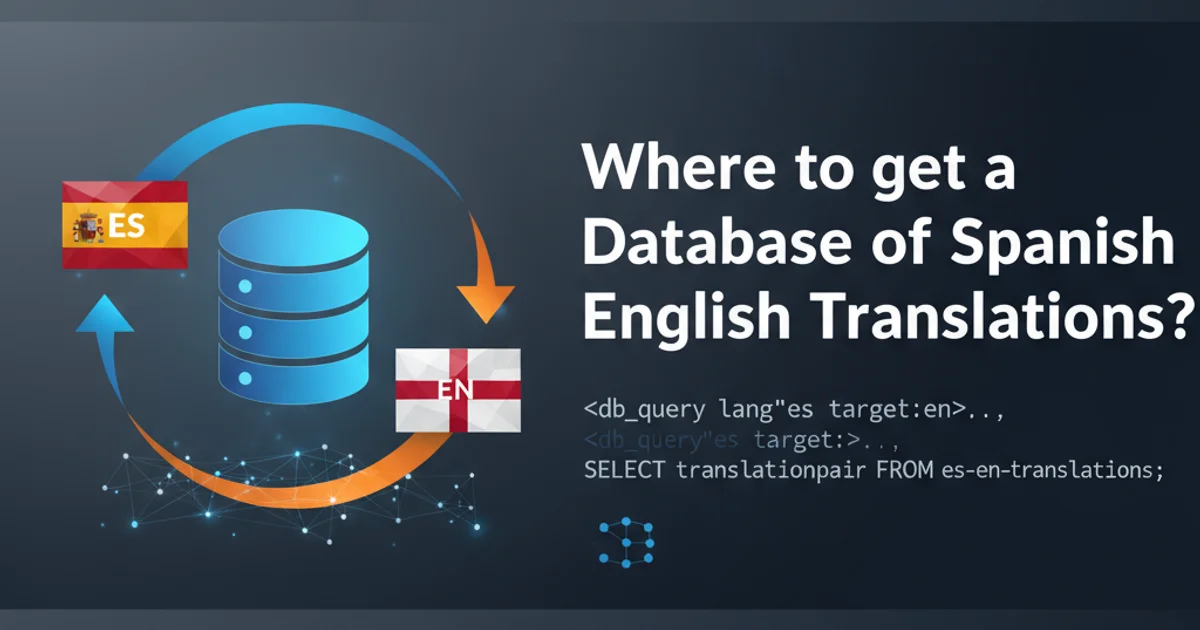Where to get a Database of Spanish <-> English Translations?
Categories:
Finding and Utilizing Spanish-English Translation Databases

Explore various resources for obtaining comprehensive Spanish-English translation databases, from open-source projects to commercial APIs, and learn how to integrate them into your applications.
Accessing reliable and extensive Spanish-English translation data is crucial for many applications, including natural language processing, machine translation, educational tools, and localization efforts. This article will guide you through the landscape of available databases, highlighting their strengths, weaknesses, and typical use cases. We'll cover everything from publicly available datasets to commercial solutions and how to approach integrating them.
Understanding Your Translation Database Needs
Before diving into specific resources, it's important to define what kind of translation database best suits your project. Consider factors such as vocabulary size, domain specificity (e.g., medical, legal, technical), licensing, update frequency, and data format. A simple word-to-word dictionary might suffice for basic lookups, while complex machine translation systems require parallel corpora—large collections of texts translated by humans.
flowchart TD
A[Define Project Needs] --> B{Vocabulary Size?}
B -->|Small| C[Basic Dictionary]
B -->|Large| D[Comprehensive Lexicon]
A --> E{Domain Specificity?}
E -->|General| F[General Corpus]
E -->|Specific| G[Specialized Corpus]
A --> H{Licensing & Cost?}
H -->|Free/Open Source| I[Public Datasets]
H -->|Commercial| J[API/Subscription]
C --> K[Choose Resource]
D --> K
F --> K
G --> K
I --> K
J --> KDecision flow for choosing a translation database.
Open-Source and Publicly Available Datasets
Many valuable translation resources are available for free, often under open licenses, making them ideal for research, educational projects, or applications with budget constraints. These typically come in the form of parallel corpora, dictionaries, or lexical databases.
Here are some prominent examples:
- Wiktionary: A collaborative, multilingual dictionary that often includes translations, definitions, and etymologies. Data can be parsed from its XML dumps.
- Europarl Corpus: A parallel corpus derived from the proceedings of the European Parliament, available in 21 European languages, including Spanish and English. Excellent for formal, political, and legal domains.
- OpenSubtitles Corpus: A massive collection of movie and TV show subtitles, offering a rich source of colloquial and informal language. Available in many language pairs, including Spanish-English.
- Tatoeba: A collection of sentences translated by volunteers, focusing on providing example sentences for language learners. It's a great source for diverse sentence structures and common phrases.
- Global WordNet Association: Provides access to various WordNets, including Spanish and English, which are lexical databases structured around semantic relations.
import xml.etree.ElementTree as ET
def parse_wiktionary_dump(file_path):
# This is a simplified example. Actual parsing is more complex.
# Wiktionary dumps are large and require careful processing.
# Consider using libraries like 'mwxml' or 'wikitextparser'.
print(f"Simulating parsing of {file_path} for Spanish-English entries...")
# Example: Look for specific page titles or templates
# For real use, you'd iterate through pages and extract relevant sections.
# Example of a simple entry structure (conceptual):
data = {
"hola": "hello",
"gracias": "thank you",
"por favor": "please"
}
return data
# Example usage (conceptual)
wiktionary_data = parse_wiktionary_dump("enwiktionary-latest-pages-articles.xml")
print(f"Extracted sample: {wiktionary_data.get('hola')}")
Conceptual Python code for parsing a Wiktionary XML dump. Actual implementation is more involved.
Commercial APIs and Subscription Services
For higher accuracy, broader coverage, domain-specific terminology, or managed services, commercial solutions are often the best choice. These typically offer robust APIs for real-time translation or access to curated, high-quality datasets.
Key providers include:
- Google Cloud Translation API: Offers powerful neural machine translation (NMT) with support for many languages, including Spanish and English. It also provides a Translation Hub for managing and customizing translations.
- DeepL API: Known for its high-quality, natural-sounding translations, particularly strong for European languages. Offers both free and paid tiers.
- Microsoft Translator Text API: Part of Azure Cognitive Services, providing scalable and customizable translation services.
- Amazon Translate: An NMT service that delivers fast, high-quality, and affordable language translation.
- SDL Trados, MemoQ, etc.: These are Computer-Assisted Translation (CAT) tools that often come with access to vast translation memories (TMs) and terminology bases (TBs) for professional translators and localization teams. While not raw databases, they provide managed access to such data.
from google.cloud import translate_v2 as translate
def translate_text_with_google_api(text, target_language='es', source_language='en'):
translate_client = translate.Client()
result = translate_client.translate(
text,
target_language=target_language,
source_language=source_language
)
return result['translatedText']
# Example usage
english_text = "Hello, how are you?"
spanish_translation = translate_text_with_google_api(english_text, target_language='es')
print(f"English: {english_text}")
print(f"Spanish (Google Translate): {spanish_translation}")
spanish_text = "¿Cómo estás hoy?"
english_translation = translate_text_with_google_api(spanish_text, target_language='en', source_language='es')
print(f"Spanish: {spanish_text}")
print(f"English (Google Translate): {english_translation}")
Python example using Google Cloud Translation API for Spanish-English translation.
Integrating and Managing Translation Data
Once you've identified your data source, the next step is integration. For raw datasets, this might involve parsing files and loading them into a local database (e.g., SQLite, PostgreSQL). For APIs, it means making HTTP requests and handling responses. Consider using a dedicated database for your translation memory or terminology base to ensure efficient lookups and updates.
graph TD
A[Data Source (Open/Commercial)] --> B{Data Format?}
B -->|XML/TXT/CSV| C[Parse & Clean Data]
B -->|API/JSON| D[API Integration]
C --> E[Store in Local DB (SQLite/PostgreSQL)]
D --> F[Cache API Responses]
E --> G[Application Logic]
F --> G
G --> H[User Interface/Output]
subgraph Data Management
E --"Efficient Lookup"--> G
F --"Rate Limiting"--> G
endWorkflow for integrating and managing translation data.
1. Choose Your Database Type
Decide between open-source datasets for flexibility and cost-effectiveness, or commercial APIs for convenience, scale, and advanced features.
2. Acquire the Data
Download raw files, subscribe to an API, or utilize a service. Ensure you understand and comply with all licensing terms.
3. Process and Store
For raw data, parse it into a structured format and load it into a database. For APIs, implement client-side logic to make requests and handle responses, potentially caching results.
4. Integrate into Application
Develop functions or modules that query your chosen data source or API to retrieve translations as needed by your application.
5. Maintain and Update
Regularly check for updates to open-source datasets or monitor changes in commercial API offerings to keep your translations current and accurate.